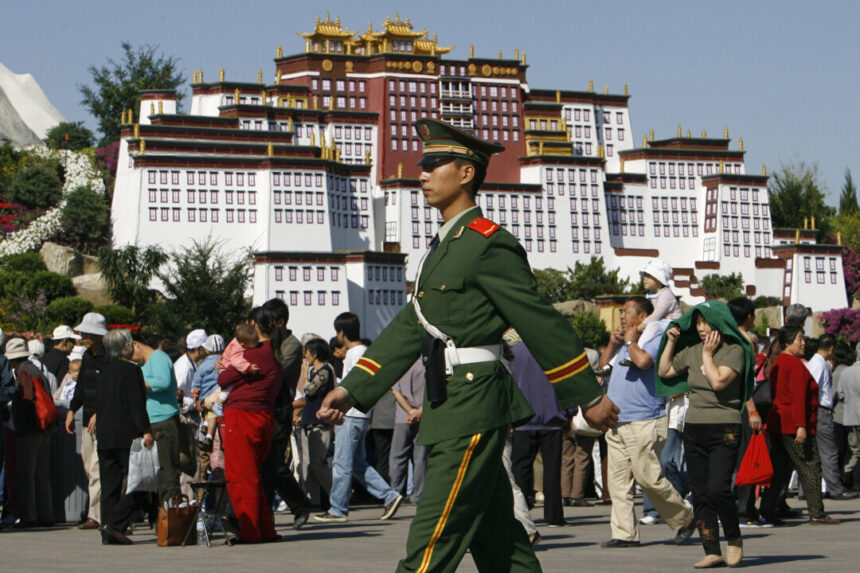Commentary
Forced assimilation into the dominant Han culture in China has been an on-again-off-again practice for centuries. To the Han Chinese who control the Chinese Communist Party (CCP), Han culture is Chinese culture, and forced assimilation is a means of achieving national unity and enhancing domestic security and control of all Chinese people.
CCP leader Xi Jinping’s “Great Rejuvenation” contains a racist element that requires a homogenization of the entire Chinese population, even if the measures to accomplish this involve cultural genocide and, ultimately, cultural extinction of minor cultures in China.
Let us examine the topic by focusing on the forced assimilation of Uyghurs and Tibetans.
From Minority Preferences to Minority Extinction
During the early communist era in China, Mao Zedong’s game plan for ethnic minorities was to “recognize ethnic diversity into irrelevance” by embracing all ethnic identities to preempt threats of local nationalism to CCP political control. He believed that he could replace people’s devotion to their religion, culture, or ethnic group with “Maoist thought.”
However, over time, Mao and his Han Chinese cadres became distrustful of Chinese minority groups because the expected assimilation into the CCP’s vision of a people united under communism failed to materialize, and major purges were conducted in Inner Mongolia and Tibet that targeted and decimated ethnic minorities.
In the 1980s, China implemented its open-door policy under Hu Yaobang. According to University of Tokyo professor Hirano Satoshi, as part of a decentralization agenda to jumpstart the Chinese economy, Hu “adopted a
minority preference policy” that included building ethnic schools to provide minorities with education in their own languages instead of Mandarin. The policy also included preferential university admissions for minorities and permission to exceed the national one-child policy in certain agricultural regions.
In an op-ed published by The Japan Times, the professor noted that “ethnic schools and preferential treatment of minority students were intended to increase the number of Communist Party members and senior officials … and companies among ethnic minorities so that they could contribute to uniting and developing the Chinese nation at higher levels.”
“In this sense, we can’t say Hu’s minority preference policy renewed the relationship between the Han Chinese and ethnic minorities,” he added.
Enter Xi and his “great rejuvenation,” which ultimately involves a return to Mao-era political and cultural controls, especially an enhanced centralization of political power in the CCP that includes the assimilation of minority groups. In one of his periodic head-scratching pronouncements,
Xi remarked while presiding over a group study session of the CCP’s Politburo last fall that “a scientific and sound theoretical system for the Chinese national community needs to be established” while “stressing that efforts must be made to integrate Marxist ethnicity theories with China’s specific realities and fine traditional culture.”
Apparently, some of those “Marxist ethnicity theories” were manifested in the
China National Program for Child Development (2021–30), which is a direct attempt to forcibly assimilate the 55 minority groups into “Chinese (Han) culture.” Rather than being taught in their own languages, ethnic minority students are now forced to read and write in Mandarin in the classroom.
It should be noted that eradicating or reducing the use of a language—that is, “
linguistic genocide”—has been a recurrent method throughout history for systematically eliminating languages, and is one of the widely used tactics of forced assimilation and cultural extinction.
The Uyghur Experience
Today, Han Chinese comprise over 90 percent of the total population in China. The approximately 108 million who are members of the 55 ethnic minority groups in China primarily occupy the fringe areas along the country’s northern, western, and southern periphery. Two of the biggest targets of the CCP’s forced assimilation campaign have been East Turkmenistan and Tibet.
Over the past 300 hundred years, Han Chinese have poured into East Turkmenistan. Many Uyghurs consider calling their region “Xinjiang”—which is Mandarin for “
new frontier”—to be a gross insult against their culture and history, which predates the Han Chinese aggressors/colonizers by hundreds of years. Of the approximately 25 million people there today, some 45 percent are Uyghur, 40 percent Han Chinese, and 7 percent Kazakh, with the remainder a mixture of ethnic minority groups.
Several indigenous separatist organizations, including the
East Turkestan Islamic Movement, have sought to establish a separate political entity in Central Asia. The CCP considers ETIM to be a terror group to be eradicated. The CCP is sweeping the region with a big broom to suppress all such groups, as at least 1 million Uyghurs have spent time in one of the
380 “detention camps” in Xinjiang harvesting cotton and performing other forced labor while being “reeducated” in the CCP’s doctrines.
The Human Rights Watch World Report 2024 highlights a range of abuses committed by the Chinese Communist Party (CCP) against Uyghurs, including mass arbitrary detention, torture, enforced disappearances, mass surveillance, cultural and religious persecution, separation of families, forced returns to China, forced labor, and sexual violence. This includes the forcible assimilation of Uyghurs through Sinicization of Islam, targeting of cultural and religious practices, family separation, arbitrary arrests, rapes, torture, and enforced disappearances.
This is what “assimilation with Chinese characteristics” means to Uyghurs: the eradication of their culture at the hands of the CCP.
The Tibetan Experience
Historically independent, Tibet faced a turning point in 1951 when the CCP imposed the Seventeen Point Agreement for the Peaceful Liberation of Tibet on Tibetan delegates. Since then, Tibet has endured forced assimilation by the CCP, which views Tibetan identity, including Buddhism, language, history, and heritage, as threats to its agenda of “great rejuvenation.” This has led to relentless persecution of the Tibetan people, reflected in Tibet’s dismal human rights ranking of 1 out of 100 in the 2021 Freedom in the World Report.
The Human Rights Watch World Report 2022 highlights the CCP’s coercive assimilationist policies in Tibetan areas, such as mandating Chinese as the medium of instruction in kindergartens and emphasizing subordination of minority identities to a single national identity. Severe restrictions on religious, expressive, movement, and assembly freedoms have been enforced, with incentives for citizens to inform on those who defy CCP laws.
Moreover, Chinese state media’s shift to using “Xizang” instead of “Tibet” underscores the CCP’s relentless efforts to erase Tibetan culture and identity from history.
Concluding Thoughts
While Xi Jinping promotes unity among ethnic groups, the reality on the ground reveals a starkly different picture of cultural genocide and forced assimilation of minorities in East Turkmenistan and Tibet. The CCP’s actions amount to crimes against humanity as ancient cultures face obliteration in the name of domestic tranquility.
Views expressed in this article are opinions of the author and do not necessarily reflect the views of The Epoch Times.







